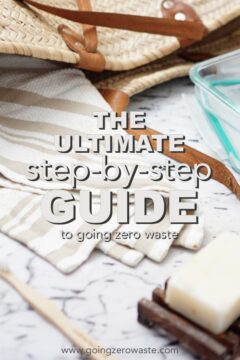Going Green Beginner’s Guide: 10 Ways to Live an Eco-Friendly Lifestyle
Zero Waste for Beginners
April 12, 2024 | Kathryn Kellogg
Last Updated on April 12, 2024
You’ve probably heard the term “going green” before: But what exactly does it mean? And is there a difference between going green and being sustainable?
Not really: Going green basically means living a sustainable lifestyle or choosing to make more eco conscious choices.
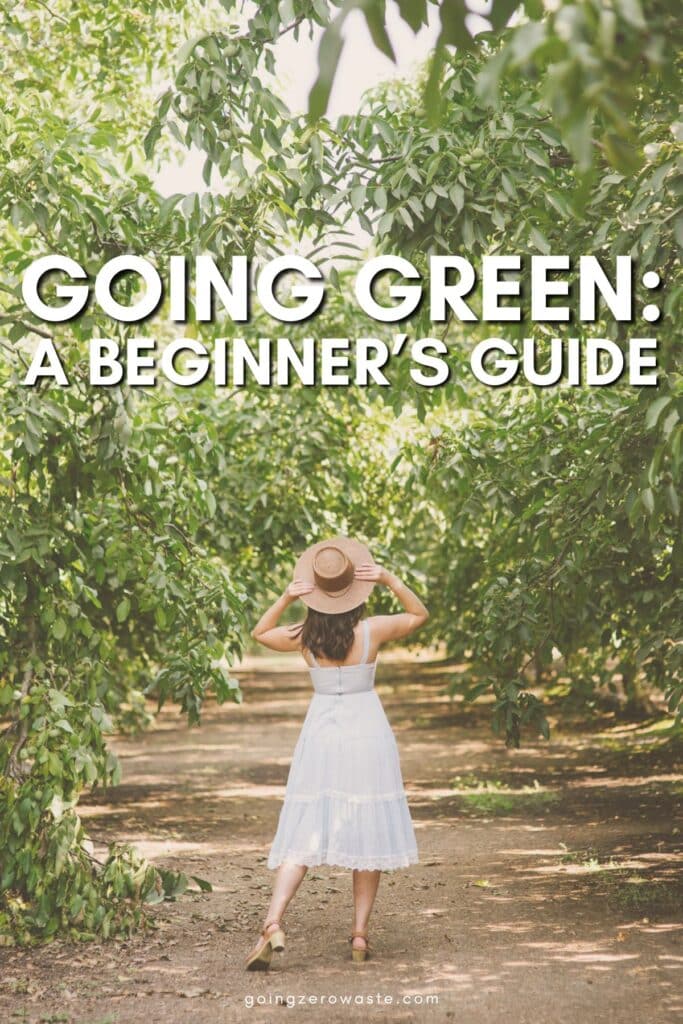
In my own life, I “go green” by choosing to reduce the amount of single-use plastic in my life, bike or walk to my destinations, and eat a plant-based diet. All these individual choices help reduce my carbon footprint and promote a sustainable lifestyle.
That said, you can also go green through collective action as well: Participating in climate marches, signing petitions, and pushing climate policy are just a few examples of this. Remember: Individual and collective action both matter and aren’t mutually exclusive.
If you want to learn how to live a more sustainable lifestyle, here’s everything you need to know about going green.

Table of Contents
what does going green mean?
Going green means being more eco conscious and changing your lifestyle to reduce your overall impact on the planet.
When you go green, you become more environmentally aware and recognize the choices you make have some kind of impact on the planet, good or bad.
For example, maybe you started to notice all the plastic you use and then find out only 5-6% of it is recycled. This may motivate you to “go green” by reducing your plastic consumption where you can.
Or, perhaps you’ve witnessed the effects of climate change firsthand. Many people are starting to go green because they’ve seen the effects of climate change and want to act.
Climate change refers to long-term shifts in temperature and weather patterns. Human activity has been the main driver of climate change, primarily due to the burning of fossil fuels, like coal, oil, and gas.
The consequences of climate change include, but are not limited to: Intense droughts, water scarcity, severe fires, rising sea levels, flooding, melting polar ice, catastrophic storms and declining biodiversity.
One way to combat climate change is to go green, both on an individual and collective level. We can do this through mindset shifts, sustainable swaps, and holding corporations and government accountable.
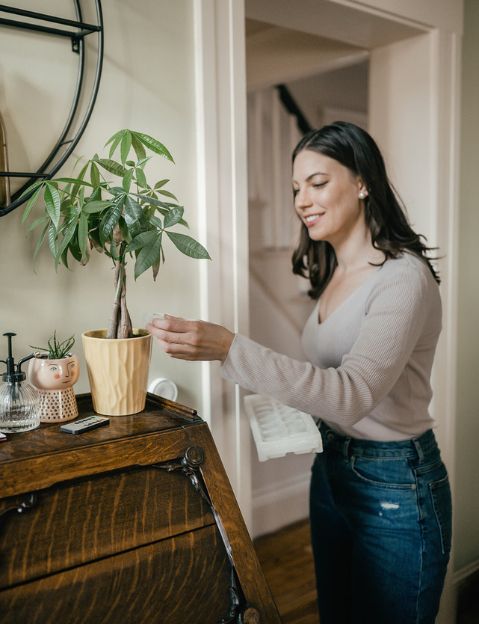
what are examples of going green?
There’s no one way to go green. There are so many different ways to lessen your impact on the environment.
For example, I started my journey into green living through the zero waste movement. Zero waste focuses on reducing trash and creating closed-loop cycles of production.
But there are so many other ways to go green that aren’t limited to just pertaining to physical forms of waste.
Some examples of going green include, but are not limited to:
- Reducing single-use plastic consumption
- Eating less meat and dairy (or completely omitting it)
- Biking, walking, carpooling, or taking public transportation more
- Supporting organic and regenerative farming practices
- Thrifting for clothes, furniture and small appliances
- Avoiding impulse purchases and consuming less
- Eating local, seasonal produce
- Growing a pesticide-free vegetable garden
- Reducing water waste
- Switching to renewable energy
- Planting native plants instead of lawns
- Supporting conservation efforts of natural spaces
what does going green mean for kids?
Speaking to kids about going green is incredibly important. Doing so fuels their love for the planet and will encourage them to adopt sustainable habits early on.
Getting your kids to go green doesn’t have to be hard or full of doom and gloom. You can focus on the beauty of Earth and show them fun ways to protect it.
Here are some ways to get your child involved in green living:
- Get them to take the zero waste challenge for kids! Every day, they’ll learn about one new sustainable swap they can make to reduce pollution.
- Introduce them to some sustainable crafts and projects. Things that will get their hands dirty, like making and using plant paints, are a fun and engaging way to teach them sustainable practices.
- Encourage them to create sustainable science experiments. You can do these from the comfort of your home.
- Buy them books on sustainability, or borrow some from the library. After reading one or two of the books on this list, it’s good to follow it up with action. This will help your child better absorb what they’ve read and apply it.
- Lead by example: Create sustainable habits in your own life and they’re bound to notice. Kids are very observant and may even adopt your habits as their own.
what are 10 ways to go green?
There are so many ways to go green but let’s dive into ten ways to get you started. You can pick and choose which you’re most interested in to follow. Or you can make small swaps in each category! Just remember, doing something is better than nothing.
Also, going green isn’t limited to just these ten habits! Be sure to do your research and make your own educated decisions.
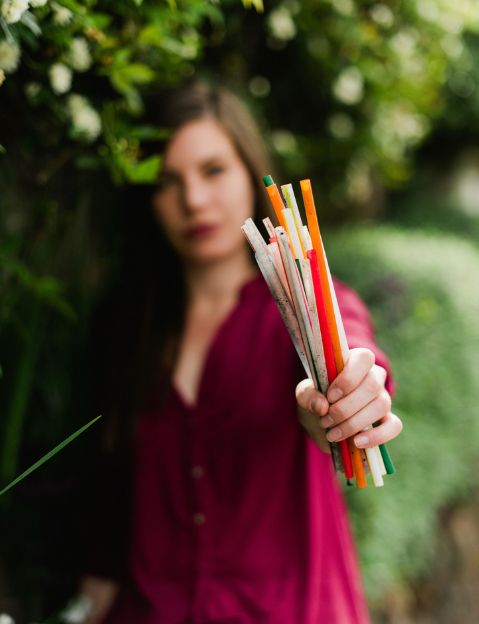
1. reduce plastic waste
Over 8.3 billion tons of plastic have been generated since the 1950s. Yet only 5% of that plastic actually gets recycled, which is down from 9%.
We’re not getting better at recycling plastic, we’re getting worse. It doesn’t help that there are seven different kinds of plastic, and every state (even down to the town) has different recycling regulations.
The best solution is to reduce plastic waste where you can. Choosing reusables and saying no to single-use plastic is the best way to do this.
Here are some ways you can reduce plastic waste:
- Do a trash audit to see where you stand on trash. Did you find a lot of plastic cups? Takeout containers? This will help you see what areas you need to pinpoint and make changes to.
- Start with the big four: Water bottles, plastic bags, straws and takeaway coffee cups. Opt for reusable versions of these items and stash them in your car or purse.
- Invest in eco-friendly items when you’ve used up your current stuff. Ex: After you finish your toothpaste, consider switching to toothpaste tabs in plastic-free packaging.
- Avoid judging others on their plastic use. Instead, direct that frustration towards big plastic polluters, like Pepsico and Coca Cola.
- Write to your favorite brands that use plastic packaging and ask them to consider more eco-friendly packaging options.
- Don’t sweat the small stuff: No one is perfect. Sometimes, a plastic straw will come with your drink. Sometimes, you can’t avoid buying the veggies wrapped in plastic. Don’t let anyone make you feel guilty for this. Just keep moving forward!
Here are some articles all about zero waste living:
- The Beginners Guide to Waste Reduction
- My Top 10 Favorite Zero Waste Swaps
- 20 Easy Sustainable Swaps
- 8 FREE Zero Waste Swaps
- What is Zero Waste? What is the Circular Economy?
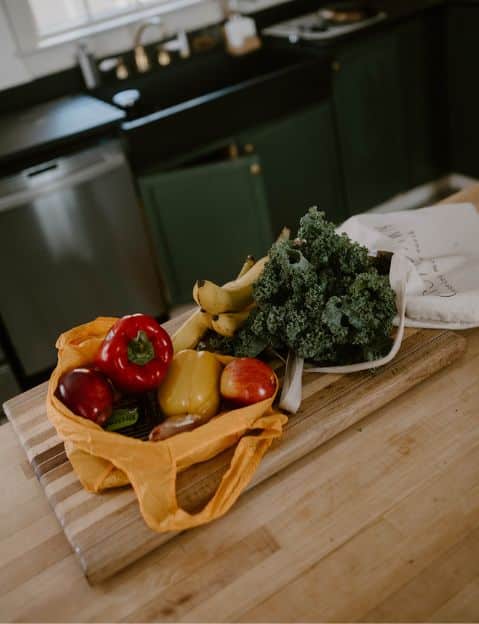
2. eat a plant-based diet
Eating more plants instead of animal products can result in lower emissions.
A vegan diet can reduce climate heating emissions by 75% compared to a diet that includes animal products. Also, 80% of deforestation in the Amazon is due to the expansion of livestock farming and feeding animals.
Choosing a whole-foods approach to a vegan or plant-based lifestyle is the best choice. Try to incorporate fresh greens and veggies whenever possible, along with beans and legumes, over processed vegan foods.
Here’s how to get started on a plant-based diet:
- Stock up on essentials in your pantry and fridge. Choose plant proteins like tofu, chickpeas, lentils and nuts. For milk, butter and cheese, there are several vegan alternatives to choose from in stores. For eggs, try out different egg substitutes.
- Get some snacks. Seasonal fruits, nuts, hummus, guacamole, and salsa are just a few to try.
- Plan your meals. Take some time to map out what dishes you’d like to prepare for breakfast, lunch and dinner. Look up vegan versions of your favorite dishes for inspiration.

3. ditch single-use paper products
We use a lot of single-use paper products: Paper towels, paper napkins, and toilet paper.
Did you know it takes 12 trees and 20,000 gallons of water to make one ton of paper towels? In the U.S., we currently use more than 13 billion pounds of paper towels each year, and most just end up in a landfill.
While I won’t recommend ditching toilet paper, I will say there are more sustainable alternatives than the conventional brands for each of these items.
Here are some options to consider:
- Make the switch to reusable paper towels. You can use these to dry your hands, wipe up spills, and dry the dishes.
- Invest in reusable cloth napkins. You can use these to wipe your hands and mouth at the table. Just toss them in the wash when you’re done.
- Switch to a more sustainable toilet paper option. I love Who Gives a Crap: They make toilet paper from recycled paper. They also offer toilet paper made from 100% bamboo. Both are kinder to the environment, and they ship plastic-free.
RELATED: Zero Waste Cloth Paper Towel Tips

4. drive less
Most cars still use internal combustion engines (ICE), which means they run on fossil fuels. When these gases leave your tailpipe, they contribute to climate change.
In the US, the transportation sector produces a quarter of total greenhouse gas emissions. Over 57% of these emissions come from vehicles like cars, small trucks, and SUVs.
According to the EPA, burning a gallon of gasoline produces nearly 9kg of carbon dioxide (CO2). It stacks up to ~4,600kg of CO2 per automobile year. That’s about a third of an average American’s carbon footprint.
Simply driving less can cut down on your carbon footprint. You can do this by walking and biking shorter distances. Investing in a good set of walking shoes and bike gear is essential. In some cities you can also rent a bike (like CitiBike). Or, if you know someone who has a bike, see if they’d be willing to lend it to you.
If you must travel farther, opting to carpool or get public transportation is the better option. Carpooling with friends or family is always a fun option. But you can also get an Uber or Lyft (these apps even let you request an EV!).
Buses, subways and trains can carry far more people than personal automobiles. This means they have far fewer emissions per passenger.
If you have the option to, consider working from home (aka telecommuting) whenever you can. This saves you from unnecessary trips to the office and may even save you on gas money.
If you must travel with a car every day, consider upgrading to greener model. Electric cars (EVs), plug-in hybrids and standard hybrids are all good options to consider.

5. stop supporting fast fashion
According to the British Fashion Council, we have enough clothing on the planet to dress six generations.
Yet, every second, the equivalent of a trash truck load of clothes is burnt or buried in a landfill. Textile production contributes to climate change more than international aviation and shipping combined.
On top of this, most of the clothes we wear today are made from synthetic fabrics, like polyester, which is fossil fuel derived. These shed microplastics over time and whenever we wash them.
Here’s how we can stop supporting fast fashion:
- Avoid supporting big companies like Shein, H&M, Temu, Amazon and Forever 21. These companies, among many others, produce excess amounts of clothing (and various other items) at the expense of people and planet.
- Take care of the clothes you own. Be an outfit repeater. Wash your clothes according to the care instructions to make them last.
- Go thrifting when you need something new. Or, borrow from a loved one.
- Consider renting clothes if you will only use the outfit once (like to a wedding).
- If you must buy new, choose to support sustainable clothing brands.
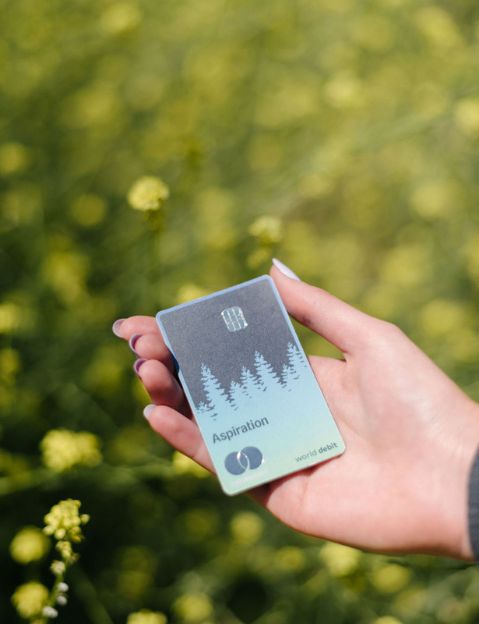
6. switch to a green bank
Your bank may be directly funding the fossil fuel industry. Sixty of the largest banks in the world have invested $3.8 trillion in fossil fuels since the Paris Agreement.
Our savings and checking accounts are being used to fund all sorts of projects, but many banks aren’t transparent about how they’re using our money.
They could be investing in thousands of projects you don’t agree with like drilling, mining, fracking, for-profit prisons, tobacco, pipelines, and so much more.
Here are the big bad four:
- JP Morgan Chase
- Citibank
- Wells Fargo
- Bank of America
According to the Banking on Climate report, these banks have invested the most money in fossil fuels, and JP Morgan Chase leading the way at $317 billion.
If you have your money with these banks, I highly recommend taking it out. Put it with a local credit union or put it with one of these sustainable banks.
RELATED: A Beginner’s Guide to Fossil Fuel Divestment
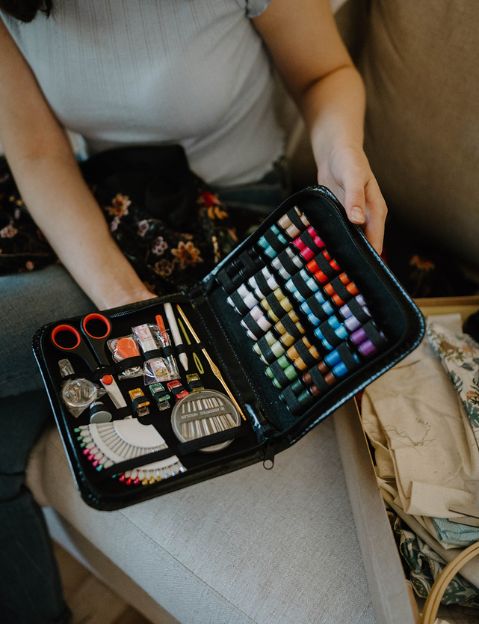
7. repair and re-use what you have
Using what you have will always be the most sustainable option. You should never feel pressured to run out and buy the latest “sustainable product” just because.
I still have old-plastic Tupperware. I am careful about what I store in it, but I definitely still use it.
All my cloth towels are stained. Heck, half of them are old t-shirts.
I like getting creative with what I have, being part of my buy nothing group, and thrifting things when I need them.
Don’t focus on what you can buy, but on what you can do. That includes repairing items when they rip or break!
Here are some articles all about repairing and caring for your items:
- How to Sew a Button + 5 Other Clothing Fixes
- Sustainable Living: 4 Things You Should Know How to Fix
- How to Take Care of Your Sweaters
- 5 Ways to Maintain and Care for Clothes

8. have an energy-efficient home
Each area of the home uses a lot of energy. The kitchen is a perfect example: This is one of the most appliance heavy rooms in the house, and many of them stay plugged in 24/7 which is responsible for oh-so-spooky *phantom electricity*.
Phantom Electricity makes up more than 10% of an average home’s annual electricity bill.
Phantom electricity happens when electronic devices are plugged in but not actively working. If you have a toaster plugged in and sitting on your counter, it’s still drawing electricity from the power grid.
While it’s not drawing a ton of power, it’s still enough to add up on your electric bill. Other kitchen examples would be your dishwasher, microwave, toaster or a blender plugged in even when not in use.
Here are some ways you can reduce energy consumption in your home:
- Unplug your appliances, gaming systems, and electronics when not in use.
- Turn off the lights when you’re leaving a room.
- Keep the thermostat set to a temperature that’s not too cold in the summer, nor too warm in the winter.
- Keep your fridge door closed, and keep it fully stocked.
- Air dry your dishes.
- Chop smaller vegetables: The smaller they are, the less time it takes to cook them, which means less time the oven needs to be on.
- Cook with the lid on to speed up the cooking process.
- Use an electricity-free bidet attachment in the bathroom.
Here are some articles that will help make your home more energy efficient:
- Energy Star Appliances: Can They Save You Money?
- How to Save Money on Your Electric Bill in the Kitchen
- 6 Ways to Save Money on Your Electric Bill in the Bathroom
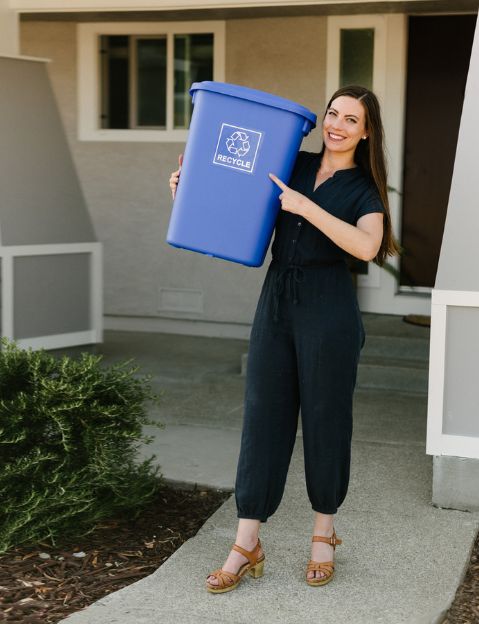
9. recycle properly
A lot of people wishcycle. Wishcycling is when you toss something into the recycling bin and hope it gets recycled, even if you’re not sure it will.
When you do this though, you run the risk of the whole recycling bin becoming contaminated (and thus, unrecyclable).
Instead, brush up on your local recycling regulations: They vary from state to state, or sometimes even from town to town. Something that’s considered recyclable in New York, may not be in Texas, and vice versa.
You can usually check your local state’s website for information. Once you find out what’s recyclable, consider printing it out or writing it down on scrap paper. Then, hang it somewhere you can see every day, like the fridge door.
Here are some articles that can help you recycle properly:
- The 7 Types of Plastic You Need to Know
- Recycling 101 – 5 Easy Things EVERYONE Needs to Know!
- How To Recycle Your Pizza Box
- How to Recycle E-Waste the Right Way!
- Paper Recycling 101
- How to Recycle Metal the Right Way!
- Textile Recycling Near Me: Where to Recycle Your Clothes
- How to Recycle Cellphones + Why You Should
- What to Do with CDs and Tapes: Recycling Tips and Tricks
- How to Recycle Ink Cartridges

10. support a sharing economy
Last but not least, find ways to support a sharing economy. Today, we are largely disconnected from each other, despite being connected by the internet.
Very few of us know our neighbors and there’s a huge push for individuality. This is fueled by the linear economy we live in where items are designed for the landfill.
We’re encouraged to buy more and constantly bombarded by ads. Even on TikTok or Instagram, someone is always trying to sell you something.
But the planet doesn’t need us consuming more stuff: In fact, we should be buying less, and sharing more.
Here are some ways we can participate in a sharing economy:
- Host or attend a clothing swap with friends and family.
- Visit the library where you can check out books, magazines, CDs, DVDs, and even attend free workshops.
- Join a community garden.
- Growing excess food? Put it outside your home with a sign that says “free” on it.
- Start a little free library.
- Host or attend a potluck with your neighbors.
- Consider starting a repair cafe, or join a maker’s space.
- Borrow tools and gardening supplies from a neighbor or loved one.
- Start a seed library.
- Offer to carpool your neighbor or coworkers to work.
RELATED: 5 Ways For You to Join The Sharing Economy
So, what do you think of these tips and tricks on going green? Let me know in the comments!


